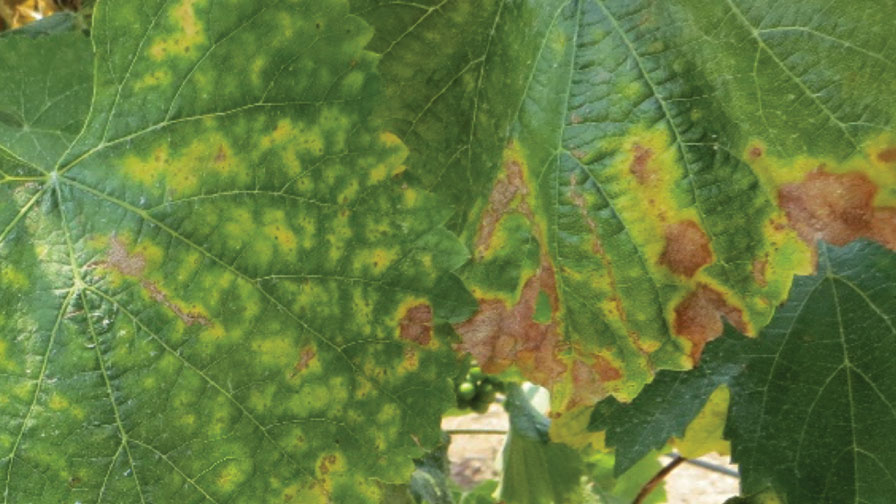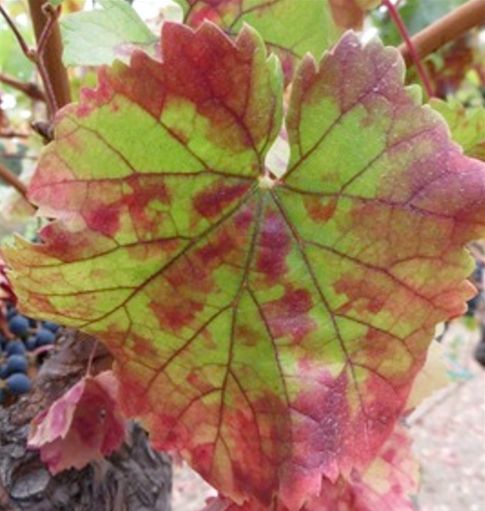Understanding the Economics Of Red Blotch in Grapes

Red blotch as seen on ‘Chardonnay’ leaves. (Photo Credit: Marc Fuchs)
Red blotch is a confounding disease in grapevines. There’s the calling card reddening of lower leaves of a vine, fruit that ripens improperly, poor fruit color, and sub-optimal fruit quality with higher acidity and lower Brix, but those could easily be mistaken for stress, nutritional disorders, or even leafroll. Once a vine has a positive diagnosis, there is no cure for red blotch.
“Bottom line: whether it is red blotch or another virus in grapes, there is no cure,” says Marc Fuchs, Associate Professor in Plant Pathology with Cornell University. “Once a vine is infected with red blotch, it remains infected with red blotch until it dies.”
The trouble, Fuchs says, is growers often don’t realize how severely red blotch impacts the vineyard’s bottom line.

The reddening of leaves is a symptom of red blotch, as seen on these leaves on a ‘Cabernet Franc’ vine. (Photo Credit: Marc Fuchs)
“The big issue with red blotch is it doesn’t kill the vine, so growers are still making a crop but very often they are not aware of how much money they’re losing and how poor that crop is,” he says. “We underestimate incidents and impacts that this disease and virus has on the industry.”
Fuchs says the severity of red blotch can vary from year to year, based on environmental factors. This can compound a grower’s decision on how to act.
“One year it could be bad and the grower wants to pull out the vines, the next year it is more favorable growth for vine and fruit production and the fruit production is satisfactory,” he says. “The third year, it’s a bad year and he’s faced with poor production, poor quality.”
Economic Model
This underestimation is a significant problem in the grape industry, Fuchs says. So much so that Fuchs partnered with Miguel Gómez, Associate Professor at Cornell University’s Charles H. Dyson School of Applied Economics and Management, to develop economic models to help growers determine the threshold of action, corresponding to the amount of infected vines.
Gomez and Fuchs discovered the economic threshold between removing infected vines or an entire vineyard was 30%.%.
“If red blotch incidents in a vineyard are higher than 30%, based on the economic model, we recommend growers remove the entire vineyard and replant,” Fuchs says. “If the red blotch virus incidents are lower than 30%, we recommend growers scout and eliminate individual infected vines and replace them, obviously with clean vines.”

Asymptomatic red blotch ‘Pinot Noir’ grapes.
Fuchs says this economic model can be difficult for growers to understand and follow. He says growers think whole infected vineyard removal is extremely prohibitive.
“When you think about the cost of the vine—removing it and replacing it— compared to the cost of management of the entire productive vineyard, it is a drop in the bucket,” he says. “This is what growers always tend to forget. This is why our economic models on how to best manage viral diseases is so useful in making the best possible decisions not to lose too much money.”
Replant With Caution

Red blotch seen on these ‘Pinot Noir’ grapes can be symptomatic. (Photo credit: Marc Fuchs)
Once this economic model is adopted and the grower decides how to act within the vineyard, Fuchs cautions growers to be very choosy when planting new vines. Some vines are not virus tested, so even as a grower removes infected vines, new vines could be planted with the virus and the cycle could begin again.
“This is a change in culture,” he says. “People just assume when they place an order they will get clean material. If they don’t demand clean material, why would they get clean material?”
Fuchs says growers need to insist upon clean material when ordering from nurseries. Communication as simple as ordering a ‘Merlot’ clone that is virus tested (and shown to be clean) and a rootstock 101-14 that is also virus tested (and shown to be clean) – and if a grower isn’t sure ask the nursery, or a farm advisor, or Extension educators.
“Growers are the driver of how healthy their planting material is when they establish a vineyard,” he says.










